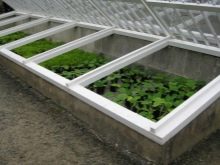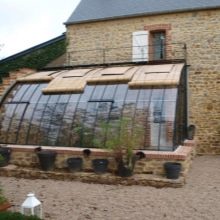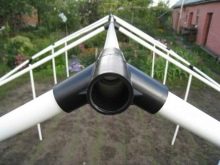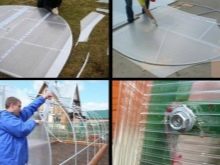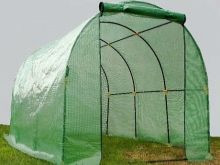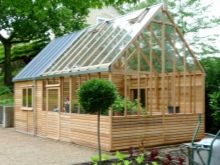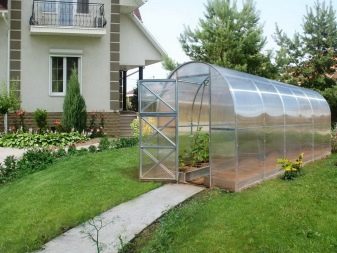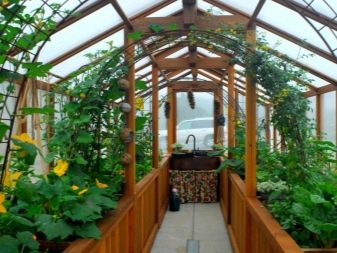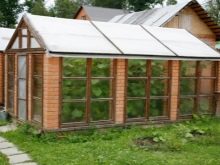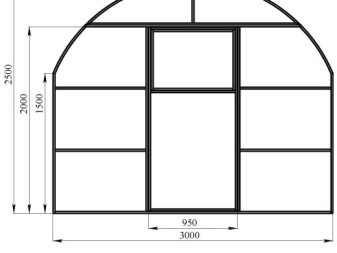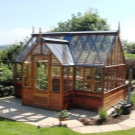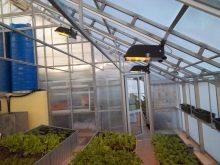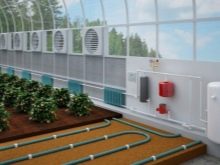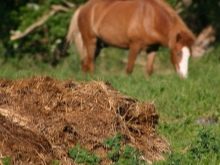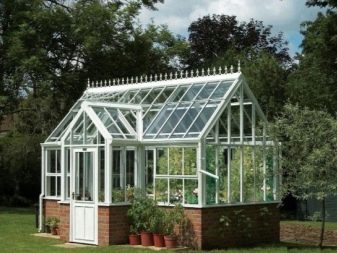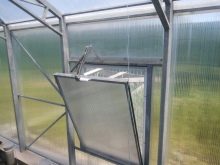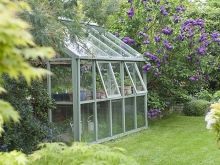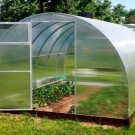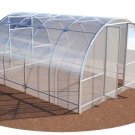Greenhouses: types, device and equipment

A greenhouse is a structure that has a transparent roof and walls, which allows light to pass through. It is intended to grow plants in autumn and spring, when the weather does not provide opportunities for harvest. To date, many effective and affordable models of greenhouses have been created. Each category has its own advantages and disadvantages, which distinguish them from other similar models.
In shape, they are small and large, rectangular, square, sloping and gable. There is even a dome model. Also, there are projects with a removable roof, made in the form of an arch, tent, attached to the house and so on. Greenhouses are standard and non-standard.For their construction you can use film, wood, metal, polycarbonate and other materials.
Note that the choice of the greenhouse project should be made depending on the goals that the person pursues, and on what he needs it for. If for growing, say, pepper, then it should be one design, and if you want to grow bananas - completely different.
Features and types
The market offers customers various categories of greenhouses. Moreover, their differences may be according to different criteria: size, price, features, type, and so on.
If we are talking about categories depending on the materials used, the following greenhouses are distinguished:
- from glass;
- polycarbonate;
- based on the film.
If we talk about the types of frames, then according to this criterion, models are distinguished:
- arched;
- in the form of a tent (house).
Greenhouses can be divided according to the material from which one or another frame is made.
As a rule, we are talking about such materials:
- polyvinyl chloride;
- tree;
- metal.
In addition, the greenhouse may be detached, and may be adjacent to the walls, that is, the wall. With stand-alone models, everything is clear and there are no subtleties.But in the second case, it turns out that one of the walls of the house or utility room acts as a supporting structure for such a greenhouse. Usually they are not collapsible, although they can be collapsible or prefabricated. They often install heating and use even in winter.
As an example of this design can be called a vegetarian Ivanova.
So call the model of the greenhouse, made of polycarbonate, built under the slope, where the wall of the house is not only a construction, but also acts as a reflector of the sun's rays. This type has shown its high efficiency in growing crops. Constructions where there are vertical walls, models built by a double arc, in the form of a pointed arch, with sloped walls, with a mansard roof, and so on will be extremely popular.
There are winter and spring greenhouses. The first ones are usually used from March to November. The second category of models requires heating. Another criterion by which such buildings are divided is mobility: there are mobile as well as stationary structures.
Requirements
Ideally, a greenhouse should have the following features:
- be high quality;
- durable;
- resistant to various types of impacts;
- reliable.
Much will depend on the goals of the summer resident himself. For example, it is important for someone that the greenhouse looks great against the background of a country house. But others believe that the greenhouse is the basis of home gardens, and it can even become a way to create a business. For such people, appearance is not the main thing.
With a stationary greenhouse, everything is simple - set and forgotten. But folding can be collected, disassembled and reassembled. But if the greenhouse is, say, at the dacha, where you are only in summer, then it is better to buy a collapsible solution due to the fact that summer residents often face property theft.
Requirements for the greenhouse will depend on what will be grown in it. Those cucumbers will require some temperatures, humidity and light levels, and tomatoes - completely different values by the above criteria. There are plants that do not tolerate neighborhoods at all and can harm each other.
When you decide what you will grow, you can already choose one or another model of a suitable height. It can be said that these requirements are not absolute and can vary, and significantly, depending on the interests of the gardener.
Materials: pros and cons
Greenhouses are created using different materials, each of which has its own special properties, as well as advantages and disadvantages.
If we talk about coverage, then there are greenhouses:
- glass;
- polycarbonate;
- film.
If it speaks of the material from which the frame is made, then only three of them are used:
- tree;
- polyvinyl chloride;
- metal.
Frame
The frame of the greenhouse can be created either from wood, or from polyvinyl chloride, or from metal. The wooden version is now used for the construction of greenhouses less and less. Wood requires special care - it must be treated with special impregnations that will protect it from various fungi, rotting, as well as other negative phenomena. Also, buildings made of wood can not be buried in the ground, if not before sheathe their waterproofing materials. If this is not done, everything will simply fall apart. In general, wood is not the best material for creating a greenhouse frame.
PVC frame is also used in the construction of greenhouses is extremely rare.
Among its advantages are:
- it is not subject to rotting, and also formation of a rust;
- it is not affected by chemicals and various kinds of fertilizers;
- material is practical to use;
- do not need any special treatment;
- has an aesthetic look.
The most common are metal frameworks. They are considered the most durable, are not exposed to rust, do not rot, do not emit any toxins, and they do not need to be painted. And if we talk about the greatest disadvantage, then it is too high the cost of aluminum fittings. This increases the likelihood that burglars can simply disassemble the greenhouse and hand over its elements to the scrap metal collection point.
The use of metal for the construction of the frame of the greenhouse is the best solution.
Coating
The film is almost the most common covering material. Its main advantage is accessibility. An equally important advantage is the possibility of independent use.
To assemble the film greenhouse personally, you will need a small number of devices, namely:
- screwdriver;
- furniture stapler;
- polyethylene film itself;
- rail.
This type of greenhouses remarkably transmits ultraviolet, which is vital for plant development. In this case, no foundation is needed.
But this type of structure has a serious number of flaws. The main thing is the fragility. The film is very easily deformed by mechanical damage and rarely remains intact even in the second year of use. That is, for the next season it is necessary to carry out a new covering of the greenhouse with a film. The frame, if it is made of a slat or a board, can serve little for more than two years. Humidity and heat - the best combination for the formation of wood fungus.
There is also a film of polyethylene reinforced type, which will have better strength characteristics. They are due to the presence of a special mesh reinforced type. Such a film can withstand not only the effects of gusting winds, but also rain with hail.
Another common material is glass. This material is much more durable and stronger than the film. Its main advantages include excellent thermal insulation and the ability to transmit light. But glass solutions have disadvantages. The air inside can overheat, which can be a destructive factor for plants.Another disadvantage is the high labor intensity of the glazing process. Given the weight of the glass, you need a really high-quality and reliable frame. The glass itself is usually at least four millimeters thick. To maximize the lighting of the greenhouse, you should increase the size of the frames.
But this will cause an increase in the cost of heating such a room. And if such a large glass is accidentally broken, then replacing it will also be very expensive. Greenhouses, made of fiberglass or glass base, can be deformed not only because of the various effects of a physical nature. Temperature extremes can also cause this.
Polycarbonate solutions in recent years are increasingly popular among summer residents and gardeners. This is not surprising, because they have a number of serious advantages over the two options described above.
More specifically, they have:
- Highest strength. It is about 200 times stronger than glass.
- Resistance to high temperatures as well as fire.
- A small mass. The mass of such polycarbonate will be 15 times less than glass, and three times less than acrylic having the same thickness.
- High thermal insulation performance.
- Low thermal conductivity.
- Excellent light transmission performance due to the high transparency of the material. This material perfectly diffuses the light.
- Good performance sound and noise insulation.
- Resistance to chemicals, as well as various atmospheric phenomena.
- Durability. Its service life is 11-13 years.
- He does not crack and does not fight.
- It has UV protection.
- Ease and flexibility.
- Nice appearance.
Polycarbonate is very easy to install and with it you can create excellent and very unusual greenhouses.
But polycarbonate has disadvantages:
- If the sheets are set incorrectly, their lifespan will decrease for a figure of two to three years.
- Almost all designs from this material require the creation of a foundation.
- Polycarbonate has a hollow structure inside that causes dirt, dust and water to enter. And this causes a drop in light transmission and significantly faster heat loss. Yes, and the appearance of this material is deteriorating.
Forms of designs
There are different forms of structures of the structures under consideration. Much will depend on this factor, starting with how much light will go inside the room and ending with the peculiarities of the formation of the microclimate.
Overview
Let's start with the arched model.It has a semicircular cross section or approximate shape to it. It is usually made from arcs that are connected to horizontal frame parts. This is the most common design. For the formation of the frame does not need a large amount of material, which reduces costs. The strength of this design is high, it can withstand the effects of snow and wind. And its arcuate shape allows the sun's rays to fall so that the plants always receive the maximum amount of light. The disadvantage is that it is very difficult to create such frame elements from metal or wood yourself. And not everyone will like their appearance.
Similar to the type described above will be the greenhouse in the form of lancet arch. It has the same rounded, but somewhat more elongated shape, which is a bit like the tip of an arrow. If we compare it with the type described above, then the resistance to snow load is even higher. On such a steep roof, the snow simply cannot linger. But to find drawings for such a building is many times more difficult than even for a model in the form of an arc.
Another view is the greenhouse, which has a gable roof.Such models are called "house". Just 20 years ago, such a building was the most common. It has good indicators of light, inside it a lot of space. It is also fairly easy to build. The frame of this model is usually made of wooden or metal parts. But there is also a minus - too much spending materials on its construction, which, naturally, will affect the price of the whole structure. This option requires the creation of props, which should protect the roof from snow pushing, which will accumulate in the winter.
The next type of greenhouses - a model with sloping walls, which is sometimes called the Dutch. It differs from the models described above in that the walls located on the sides are not strictly at an angle of 90 degrees, but at a slight slope. For this reason, the light is better refracted and the plants are illuminated with higher quality, which accelerates their growth. Such a model requires an excellent ventilation system, as well as a powerful and strong frame.
The single-sided model looks like a half of a house, where only one ramp remains from the roof. This option is being built as an extension to the cottage, fence or housekeeping.Usually in such a greenhouse carry out the early cultivation of seedlings before planting in open areas.
The next type is an A-shaped model, or, in a different way, a hothouse hothouse. If it is positioned correctly, the plants will receive a maximum of solar energy. Such a model should be necessarily equipped with windows or windows, because in the heat of the plant, located inside, waiting for overheating. To build this type of greenhouse is quite simple. Although it has a drawback - the useful internal volume is rather small. Often the building may be located just below ground level.
The next type is Mitlider Greenhouse. It was created by a specialist in the field of gardening, whose name it bears. It differs from the models listed above in that the parts of the roof are not on the same level as in all models, but on different ones. Between them is a vertical stenochka, in which a number of window vents are installed. This results in a simple but extremely effective system of airing and air circulation. This makes it possible to significantly increase the yield of plants.
The slope of the roof that faces north will usually be higher, and the one that goes south is lower.Such a model is created to maximize the collection of solar energy and maintain a favorable temperature for the growth of various crops even during the most severe frosts. To achieve this effect, the greenhouse is slightly submerged under the ground, which will be a kind of natural heat insulator. The main disadvantage of this solution is that it is necessary to dig a fairly large excavation. In addition, even before construction it is necessary to consider a system for protecting the premises from the effects of groundwater and groundwater.
Another model that deserves special attention is the greenhouse with capital walls. If necessary, the construction of such a structure should be aware that the northern side of such a building is made of timber or brick. After this, the wall is insulated from the outside. Inside the building, except for the plants themselves, put the bags, which is gravel. During the day, such volumes accumulate heat, and after sunset they begin to give it away and do it throughout the evening and most of the night.
As a result of such an uncomplicated solution, a greenhouse is obtained in which it is possible to grow plants and crops even in the winter season and not to spend much money on heating the room. There are also unusual models.This does not include, for example, a square greenhouse. In this category really extraordinary models are listed from a technical point of view. For example, a pyramid or greenhouse dome.
The price of their construction will be higher at times than the buildings of the usual form. At the same time, they stand out with an unusual and interesting appearance, as well as with quite serious characteristics in terms of accumulation and accumulation of solar heat, as well as ensuring an optimal microclimate inside the room.
There are a large number of other types of greenhouses, which are not built so often, but, nevertheless, they exist. Also today is very popular is the construction of greenhouses on an individual project. But such solutions can be afforded only by wealthy people due to the high cost of the implementation of the plan.
Comparison
The described categories of greenhouses are found today most often, but as already mentioned, the variety of designs is not limited to them at all. Each type has its advantages and features. Also, each model has its own purpose and may be more effective than a different species for growing certain crops.In selecting the shape of the greenhouse, its construction, and building materials for its production, a large number of factors should be taken into account. Comparison of various models will help determine the selection of the optimal design in each case.
The central criterion in this question will be what exactly you are going to grow. Some plants like a lot of light and high temperatures, while others do not. Similarly, various designs: some are designed to simply let the light in, while others allow it to be released much more and have an excellent ventilation system.
Today, new models of greenhouses that are manufactured using eco-materials have become very popular. They provide an opportunity to improve the characteristics of already known structures while reducing construction costs. But the effectiveness of such models has not been tested to the end.
How to choose the right one?
Only the owner to decide what kind of greenhouse to choose for placement on the dacha. But to make the right decision, you should consider a few recommendations. First, the optimal parameters of the greenhouse are considered to be 2.5 m in length to the ridge, 1.5 m in height, and 3.5 m in width. In greenhouses of this type, it will be easiest to care for the plants.If you are using a greenhouse for growing flowers, then this will be ideal.
Of course, these figures are not an axiom, they can change as the owner will be comfortable. The only thing that should not be exactly done is to stretch the greenhouse in length by more than six meters. Otherwise it will be very difficult to care for the plants. Yes, and heat such a room will be very difficult and quite expensive. If you still need a long greenhouse, it would be best to divide it into several compartments.
Choose a greenhouse better than the model, where there are wide doors. As a rule, we are talking about a figure of one meter. These doors can be easily accessed with a garden cart or wheelbarrow.
If we talk about the form, everything will depend on what exactly you are going to grow. For some plants, the ideal solution would be a round shape, for others - a rectangular, for the third - a greenhouse-hut.
When choosing a frame, you should consider the characteristics of the materials from which it can be made. The metal frame will be durable and relatively inexpensive. Yes, and a galvanized metal base will serve for a long time, since it is excellent in resisting moisture and corrosion, as well as fungus.
The wooden frame will serve substantially less.And even if you treat it well with an antiseptic, it will not be able to help you too much. But then just take care of him and it is quite affordable. A frame made of plastic pipes will last the longest. It is not exposed to rot, does not need various impregnations or painting. But with a long stay under the influence of ultraviolet rays, it can begin to deform.
Heating
Any greenhouse needs heating. The heating system can be different - from electric devices to bags of stones, in particular, gravel, which is a heat accumulator: during the day they will accumulate solar heat, and after sunset they will give it to plants almost to morning. Heating system can be performed in different ways. It will all depend on the purpose of using the greenhouse, the personal preferences of the owner, as well as his financial capabilities.
The most common type of heating of various premises, including greenhouses, will be water heating.
It may be:
- individual;
- in common with other buildings.
If we talk about the merits of this method, it should be called:
- uniform and fairly economical heating;
- lack of air drying;
- it is easy to place radiators at the bottom of the wall, which makes it possible to create the desired temperature, where the root system of plants is located.
But the mechanism also has disadvantages:
- the installation of such a mechanism requires knowledge and serious financial costs;
- such a mechanism should not be frozen, not previously drained thermal media.
The price of the system is quite high, and this option often justifies itself only in cases when the area of the greenhouse is really large. At least when it comes to gas. If you use simple boilers for solid fuels, it will be cheaper, but the presence of a person will almost always be necessary. A good option is to use electric boilers. They are available, easy to install and can be combined with any other type of heating.
Electric heating is not the cheapest option, but rather convenient.
It is interesting in that heating can be carried out using various types of heaters:
- infrared;
- heat convectors;
- heating cable.
The latter is simply laid in the ground, covering it with a pillow of sand. The earth heats up and transfers heat to the air, which, in combination with other methods of natural heating, creates an excellent microclimate inside the greenhouse. Heat convectors heat the air in the greenhouse. This option will demonstrate the greatest efficiency while maintaining the temperature at night. But this method has a drawback - the air is too dry, which for a number of plants is a very undesirable point.
If we talk about infrared heaters, then they are installed, as a rule, from above. And they do not heat the air, but they warm exactly the objects and plants that receive infrared radiation. And if you make temperature sensors at ground level, you can create an automated heating system.
Another frequently used type of heating is biological heating. This method will be an excellent solution only in the south, where sub-zero temperatures are not too high and you can easily heat the entire greenhouse with biofuels. In the northern latitudes, this method can also be used, but only as a secondary one.Biological fuel will be organic, during the decomposition of which heat is released. It can be dung, straw, paper, cardboard, chips, and so on. Mix them simply in any quantities and variations. To speed up the decomposition process, you can add to the mass of active biological substances such as "Shine" or "Baikal". They contain special aerobic parasites that contribute to the decomposition of organic residues and their rapid heating.
The last heating option I would like to consider is solar. As the name implies, it means heating the air in the greenhouse with the help of the sun. The problem is that the air itself accumulates heat extremely weakly, and after nightfall it cools quickly. Therefore, various tricks are resorted to - the walls are made of special materials that accumulate heat, then bags of gravel are put in the greenhouse, which give up the accumulated heat of the day during the night.
Another option for such heating is the use of solar collectors. They are black metal coils, which are located in a glass frame on the southern part of the roof.They are connected to the storage tank and radiator system, and then filled with water. The sun heats the coil, and with it the heat carrier, which enters the tank and goes to the heating system.
Criterias of choice
To choose the most efficient heating system for the greenhouse, you should first focus on the design of the room, which is located on your site. For example, film solutions have much greater heat loss than polycarbonate structures. For this reason, they will need more heat. And polycarbonate, on the contrary, easily maintain the desired temperature, since the polymers have high thermal insulation properties.
There are other factors on which to focus:
- the type of heating that is used in the house;
- availability for installation of a system;
- price of heating equipment;
- greenhouse area - some systems will be an excellent solution for large buildings, and in small ones they will significantly lose their effectiveness, and vice versa.
Each of the options on the market has its own advantages and disadvantages, for which reason you should first weigh the pros and cons, and only then make a choice in favor of a decision.
Accommodation: what to follow?
An important factor that has a significant impact on the cultivation of plants and crops in the greenhouse, is its proper placement. The area where your future greenhouse will be located should be well lit. And this is not only about greenhouses where fruits and vegetables will grow. Flower greenhouses also fall under these rules.
The greenhouse should be built at a distance of at least five meters from trees and various buildings.so that there are no obstacles to the penetration of sunlight into it. In places where the cold is quite strong, the greenhouse must be protected from winds. This can be done either by using insulants, or by dropping out special windproof bushes that have a thick crown. This should be done in 5-10 meters from the building. It is not recommended to locate them too close, as turbulent flows may begin to form that will flow around the walls of the building and cool it.
If you decide to make a submerged version, then it is better for it to take the highest place, where the groundwater level will be minimal. If you build a greenhouse extension, it is better to have it on the south side of the house, where the sun will be most.
Growing and watering system: options
Now let's talk about the systems of growing and watering plants for the greenhouse, and also try to understand a little about their features. The first type will be drip irrigation. This option is considered one of the most profitable. A special point mechanism can provide plants with the right amount of moisture, while not allowing the weeds to grow.
Such a system can be made not only by specialists, it can be easily implemented and independently. To make the soil moisture system itself, you should follow a clear procedure. First you need to calculate what you need for your greenhouse, and buy it all.
To install such a system, you need to have on hand such equipment:
- droppers;
- drip tape;
- tank;
- filters;
- trunk pipes;
- special fittings;
- hydraulic cylinder
It is best to use a stainless steel tank or plastic. It must be constantly closed so that it does not fall into the garbage.
To start the automatic irrigation, the water tank is installed at a height of more than one and a half meters, after which the main pipe joins it.Drip tapes are connected to the main pipe, at the ends of which plugs are installed.
The second system that needs to be mentioned is sprinkling. For some plants it is better if they receive moisture in a way close to natural. And sprinkling is just that. In this case, the water seems to be sprayed over the plants and falls in the form of small droplets, which will be like rain. One of its essential elements will be a fogger.
In order to mount such a system, it is necessary to ensure that the water pressure is constantly high. The disadvantages of such a system include the fact that a large amount of moisture can accumulate on the leaves, which for some plants can cause diseases.
The last system that I want to say about is subsurface watering. This option will be effective in areas with podzolic-sandy soils, as they retain moisture is not very good.
To install such a system, it is necessary to remove the top layer of soil and put plastic film on the bottom. It is slightly filled with soil, after which plastic pipes are installed on it, which will be responsible for the water supply.After that, the removed soil returns to the site and plants are planted.
Lighting and ventilation
Speaking of lighting and ventilation systems, it becomes clear that plants simply cannot do without it. But if there will be no problems with air even without a highly technological ventilation system, then how to deal with lighting is a big question.
Need or not?
Answering this question, we will immediately say that lighting and ventilation systems for plants in the greenhouse are vital. Any light source will be useful for plants. It can significantly increase the yield of plants. And if we are talking about the winter period of time, then there are no sources of artificial light at all. All plants need light 12-16 hours per day, and in winter, when the length of daylight hours is less than 10 hours, the relevance of lighting systems increases significantly.
The same goes for ventilation. A number of greenhouse structures, as well as the materials that are used for their construction, have certain characteristics in order to transmit as much light as possible into such a room. But this can cause too much heating of the air inside, and, as a consequence, an increase in temperature, which can be fraught with a violation of the microclimate in the greenhouse, and even the death of plants.For this reason, even if you do not think out too complicated a ventilation system, then you need to install at least simple fans.
What are: analysis
The classic lighting option will be the most common incandescent bulbs. The benefit from them is also in the fact that they warm the air a little.
True, there are disadvantages:
- not too favorable color spectrum for plants;
- consume a lot of energy;
- their prolonged use can lead to leaf deformation.
Another option that is sometimes used is high pressure mercury lamps.
This option is used for lighting, but you should be aware of its shortcomings:
- too fast heating of the lamps, which makes it impossible to use them continuously for a long time;
- too bright ultraviolet radiation, which can be harmful to plants.
The next option - fluorescent lamps. Such a solution can be called one of the best for use in greenhouses. They emit a favorable spectrum for plants. The service life of such lamps is quite long. But they also have a disadvantage - they have a low rate of thermal efficiency, since they work on the principle of energy-saving lamps.
Another lighting option is high pressure sodium bulbs. Their advantage is that they have high luminous efficacy at low power. In addition, they create light that is close to natural sunlight. At the same time, the blue part of the light spectrum, which is responsible for the growing season of plants, is rather weak here, which will be a significant disadvantage of such lamps.
Another option I would like to mention is metal halide lamps. They have a large radiation spectrum, as well as different power ranges. This option is considered one of the best for greenhouses, because the lighting from them is as close as possible to the sun. Their only significant drawback is the high price. Another disadvantage - restrictions on the position of combustion.
The last option - LED lighting. At the moment it is considered experimental and there is no exact data on its effectiveness. The first results of use indicate that it is very economical, and its efficiency is twice as high as all lighting models that are known today. But its price is high.
There are two types of greenhouse ventilation:
- natural;
- artificial.
The first is ventilation with the help of natural factors. The second is a system when efforts are required to move air masses. Here everything will rest on the design features of various greenhouses. For artificial characterized by the use of fans.
Do-it-yourself polycarbonate construction
After the place for the greenhouse has been chosen, the site is laid out to create the foundation. This is done with a peg and rope. The width of the foundation should be about thirty centimeters. Next, the fertile part of the earth is removed, the trench should be deepened to a certain depth - by 30 centimeters, if it is a question of sandy soil, and by 50-60 cm, if it is clay. Now you need to make a trench with sand with a layer of 20-30 cm.
The next step is to lay the bottom of the trench with roofing felt, which will serve as waterproofing. Next is the reinforcement of the two-level type. To do this, use a 10 or 12 mm corrugated rod with a ligation. After this, the trench with the formwork is poured with concrete and the leveling of the upper layer is carried out.Now all this is left to dry for a period from a crescent to a month.
When the foundation is dry, you need to lay a couple of layers of roofing material to carry out the foundation waterproofing from the masonry. Bricks of a corpulent type are laid over the lower part of the walls with a height from 80 centimeters to a meter. To save material, you can create a wall with a polystyrene foam to give it thermal insulation. This material will provide high-quality wind protection. Now you can proceed to the assembly and installation. On the walls it is necessary to put a board or strapping bar. It is best to fasten these materials with anchor bolts. Now with a step of 66-68 centimeters install racks. Thanks to them, it is possible to make the polycarbonate fit snugly to the bar. In addition, this can be done for overlap.
At the rack laid the top timber strapping. To increase the strength of the uprights, they can be strengthened with struts and braces. Now we are forming a gable greenhouse roof from a bar. Hanging rafters are installed on the upper type harness. To make it all durable, they are braced using crossbars.Then in the right places make openings for the doors, put the box, and then install the door itself.
At the next stage, the greenhouse is sheathed with polycarbonate sheets. They are fixed with special screws, which are equipped with rubber sealing washers. The joints are best fluff sealant based on silicone. During installation of polycarbonate sheets should pay attention to the sides of the material. The fact is that only one of them has an ultraviolet coating. On the same side the film is glued with the name of the manufacturer. To avoid deformation of this layer, the film can be removed only after the installation work has been completed.
After the greenhouse was built, it remains to carry out communications:
- water supply;
- electricity;
- heating system.
At the final stage of work, the future beds should be filled with fertile soil and the greenhouse should be heated in test mode, which will allow to check the microclimate using a hygrometer and thermometers. If the indicators are all right, then you can start growing plants and crops in it.
Ready models and reviews
Today there is a wide variety of greenhouses, so it is difficult to determine which models are the best. It can be said for sure that a country greenhouse must first of all perform its main function - to provide the plants with everything they need to bear fruit at any time of the year.
If we talk about the most popular models, they are such as:
- "Largush";
- "Botanist";
- "Leader";
- "Innovator";
- "Arrow";
- "Orange";
- "Very tight";
- "Uralochka";
- "Tsar".
All of these models can be found in the majority of positive reviews, which once again confirms the fact that these models are really the most effective and high-quality.
Using the example of one of them, we will look at how they are so good. Greenhouse "Botanik" arched or duo-pitch. If you need a gable model, it is better to make it glass, but then the weight of the structure will increase significantly and it will need a foundation. Alternatively, you can use cellular polycarbonate. The arched version will be cheaper, economical and easier to manufacture. This design is more airtight; it has significantly fewer seams.Specifically, this model is better to do the arched, because it has a simpler installation.
The advantage of this model will be a frame made of aluminum, which is simply installed cellular polycarbonate or glass. There are also models made of galvanized steel. This design is very stable and can be used for several seasons. Another advantage of the model is a pair of vents, which provide excellent ventilation of the greenhouse inside. There is also a sliding door, which can be converted into a sliding door.
Design advantages:
- lightweight aluminum frame;
- the excellent bearing profile which gives the chance to carry out installation of system of watering and airing;
- availability of shelves;
- device tying plants;
- nice appearance;
- new fixing system glasses;
- ease of assembly.
Due to the fact that there is a wide variety of modern models of greenhouses, even the most picky gardener will be able to find the very structure that will not only satisfy all his needs, but also make it possible to make the cultivation of various crops as efficient as possible.
In the next video you will find making a greenhouse with your own hands from A to Z.


